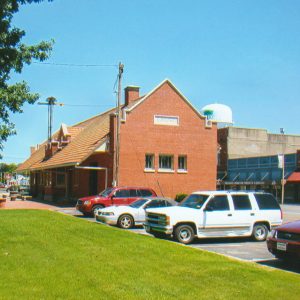calsfoundation@cals.org
Lonoke Rock Island Depot
In 1912, the Rock Island Railroad replaced a deteriorating and outdated depot that had been constructed in 1899 along the railroad tracks in Lonoke (Lonoke County). The depot was the center of commerce and travel in the small town. The new brick depot served the city for several decades and was added to the National Register of Historic Places on October 4, 1984.
The town of Lonoke, which was established along the railroad tracks connecting Memphis, Tennessee, to Little Rock (Pulaski County), was incorporated in 1872 and designated the county seat in 1873. The town soon became the commercial center of the area. A small depot, which over time proved to be inadequate, was built along the tracks in 1899.
In 1910, the Lonoke Retail Merchants and Businessmen Association petitioned railroad executives to construct a new larger depot. Almost two years would pass before the railroad company sent a local representative from Little Rock to discuss such a possibility. It was then decided that a new modern depot costing less than $15,000 would be built across the tracks from the 1899 structure. Approximately two months later, on May 16, 1912, contractor T. B. Davis began construction of the depot, and on October 27 railroad officials began moving into the depot.
The one-story red brick structure measures about 28 x 100 feet and is divided into three areas: shipping, offices, and passenger. Each end of the building has three windows. The building also has a basement. A three-sided telegrapher’s bay, which has four windows and extends through the roof, is located on the north side. The north side, which faces the tracks, also has five windows, two entrance doors, and a freight door. The south side of the building, which faces U.S. Highway 70, has nine windows and a freight door. Along the peaked roof line on both ends of the depot is a stone plaque engraved, “Lonoke.” The west end of the roof ridge is topped by a brick chimney.
In the early 1980s, the Lonoke County Historical Society began a movement to restore the depot. In March 1984, the City of Lonoke purchased the inactive depot on behalf of the society. The goal was to restore the building and return it to use by the community for various activities. Before the end of the year, the building had been added to the National Register of Historic Places. Soon afterward, the city received a federal grant of $144,000 for use on the building. Much assistance was provided by Arkansas Historic Preservation Program (AHPP) officials. The AHPP met with architects to determine how to restore the building to its original condition. Included in the restoration was the repair of the tile roof, several new rafters duplicating the original ones, and a thorough cleaning of the building inside and out. Once the work was completed, the city and the historical society maintained offices there. Various community events and municipal court proceedings were also held in the building.
On May 10, 1987, the newly restored depot was formally dedicated in front of a large crowd. Among the speakers that day were U.S. Senator Dale Bumpers and state representative Bill Foster, both of whom had assisted in the preservation of the depot. At that same time, on the south side, Depot Park was dedicated to Joseph Singleton, who had been a stationmaster at Lonoke for twenty-six years.
By 2023, the building was housing offices of the Lonoke Chamber of Commerce and was being used for community events.
For additional information:
“History of the Present Lonoke Depot.” Lonoke County Historical Society Newsletter (Spring 1984): 3.
“Lonoke Rock Island Depot.” National Register of Historic Places registration form. On file at Arkansas Historic Preservation Program, Little Rock, Arkansas. Online at https://www.arkansasheritage.com/arkansas-historic-preservation-program (accessed August 8, 2023).
Meeks, Angela. “Lonoke Rock Island Depot Rehabilitation Realized through Federal-state-local Partnerships.” Lonoke County Historical Society Newsletter (Fall 1988): 5.
Mike Polston
CALS Encyclopedia of Arkansas
 Early Twentieth Century, 1901 through 1940
Early Twentieth Century, 1901 through 1940 Historic Preservation
Historic Preservation Lonoke Rock Island Depot
Lonoke Rock Island Depot  Lonoke Rock Island Depot
Lonoke Rock Island Depot 



Comments
No comments on this entry yet.